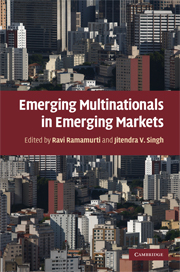Book contents
- Frontmatter
- Contents
- List of figures
- List of tables
- List of abbreviations
- List of contributors
- Acknowledgments
- Part I Introduction
- Part II Country Studies
- 5 Chinese multinationals: Emerging through new global gateways
- 6 Indian multinationals: Generic internationalization strategies
- 7 Russian multinationals: Natural resource champions
- 8 Brazilian multinationals: Surfing the waves of internationalization
- 9 South African multinationals: Building on a unique legacy
- 10 Mexican multinationals: Insights from CEMEX
- 11 Thai multinationals: Entering the big league
- 12 Israeli multinationals: Competing from a small open economy
- Part III Conclusions
- Index
- References
10 - Mexican multinationals: Insights from CEMEX
from Part II - Country Studies
Published online by Cambridge University Press: 03 July 2009
- Frontmatter
- Contents
- List of figures
- List of tables
- List of abbreviations
- List of contributors
- Acknowledgments
- Part I Introduction
- Part II Country Studies
- 5 Chinese multinationals: Emerging through new global gateways
- 6 Indian multinationals: Generic internationalization strategies
- 7 Russian multinationals: Natural resource champions
- 8 Brazilian multinationals: Surfing the waves of internationalization
- 9 South African multinationals: Building on a unique legacy
- 10 Mexican multinationals: Insights from CEMEX
- 11 Thai multinationals: Entering the big league
- 12 Israeli multinationals: Competing from a small open economy
- Part III Conclusions
- Index
- References
Summary
Since Vernon's seminal work (Vernon 1966; Vernon 1971), international firm expansion has been predominantly portrayed as a phenomenon led by firms located in economically and technologically developed countries in search of new markets, natural resources, knowledge leverage, and/or risk diversification. While venturing abroad is not devoid of obstacles (Hymer 1960; Zaheer 1995; Zaheer and Mosakowski 1997), the general view has been that developed-country MNEs were able to overcome these hurdles as a result of possessing better technologies, superior organizational processes, more financial power, or sounder home-country institutions than their host-country counterparts.
The emergence of EMNEs challenges classic theories of the international firm that attempt to explain why multinational enterprises actually exist. In response to this puzzle, a number of studies, including those in this book, have pointed at a combination of environmental and organizational factors that help us understand why EMNEs might enjoy a competitive advantage over developed-country MNEs even when competing with these firms in developed markets – labeled “up-market FDI” by Ramamurti and Singh (Figure 1.1 in this volume). Nevertheless, most of these competitive advantages appear to be temporary in nature and only provide plausible explanations as to how these EMNEs are able to take their first steps into the international competitive arena. However, they are significantly silent when it comes to explaining if and how they can sustain their competitive edge.
- Type
- Chapter
- Information
- Emerging Multinationals in Emerging Markets , pp. 280 - 311Publisher: Cambridge University PressPrint publication year: 2009
References
- 3
- Cited by

